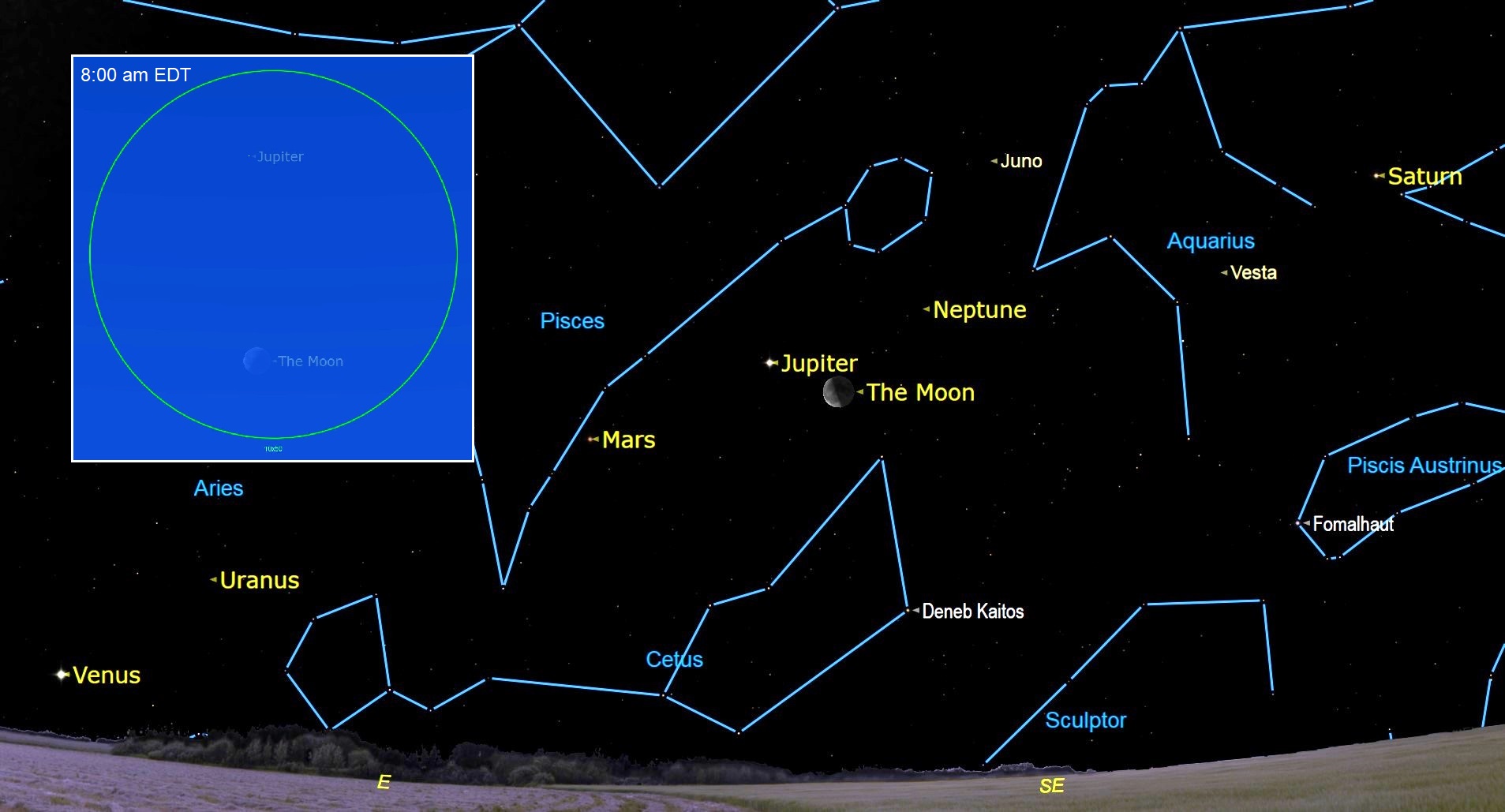The moon will cozy up to Jupiter early Tuesday morning as it continues its planetary tour
The pair will be visible to the naked eye or through binoculars this summer solstice.

Look to the east-southeastern sky in the early hours of Tuesday morning (June 21) to spot the waning crescent moon approaching Jupiter as it continues its monthly tour of the planets.
The satellite will sit just a palm's width to the lower right (or 5 degrees to the celestial southwest) of the gas giant, making for an interesting skywatching target. You'll have plenty of time to spot the duo as they will remain visible throughout the morning.
"Jupiter will remain visible to the unaided eye from the time it rises after 1 a.m. local time until almost sunrise," writes Chris Vaughan, amateur astronomer with SkySafari Software who oversees Space.com's Night Sky calendar.
The exact time of the event varies depending on your specific location, so you'll want to check out a skywatching app like SkySafari or software like Starry Night to confirm the local time to look up. Our picks for the best stargazing apps may help you with your planning.
Related: The brightest planets in June's night sky: How to see them (and when)
As the moon will remain visible in the morning daytime sky, it is possible to use the satellite as a guide to spot Jupiter in daylight through binoculars, according to Vaughan. To find the gas giant, position the moon towards the bottom of your field of view.
Summer also kicks off in the Northern Hemisphere on Tuesday (June 21), as the summer solstice marks the longest day of the year.
Get the Space.com Newsletter
Breaking space news, the latest updates on rocket launches, skywatching events and more!
Jupiter is the solar system's largest planet and hosts a whopping 79 moons. The planet contains more than twice the mass of all the other solar system planets combined as well as an infamous storm that is twice the width of Earth — the Great Red Spot.
Hoping to capture a good photo of the moon as it approaches Jupiter? Our guide on how to photograph the moon has some helpful tips. If you're looking for a camera, here's our overview of the best cameras for astrophotography and best lenses for astrophotography. As always, our guides for the best telescopes and best binoculars can help you prepare for the next great skywatching event.
The moon cozying up to Jupiter isn't the only skywatching event to look out for this month. Throughout June, a rare "planet parade" will be visible in the predawn sky as all five naked-eye planets line up in their orbital order from the sun. From left to right in the southeastern sky, you'll be able to spot Mercury, Venus, Mars, Jupiter and Saturn all in a row. (Mercury, which is usually obscured by the sun's glare will become easier to spot as the month matures.)

Looking for a telescope for the next planet sight or skywatching event? We recommend the Celestron Astro Fi 102 as the top pick in our best beginner's telescope guide.
The best opportunity to see this spectacle may come on June 24, as Mercury should rise about an hour before the sun, according to a press release from Sky&Telescope.
Throughout June, the moon will continue to journey past the morning planets, embarking on a planetary "meet and greet." After Jupiter, the next stop on the tour is Mars on June 22, Venus on June 26 then finally Mercury on June 27.
Editor's Note: If you capture a great photo of the moon during its travels and would like to share it with Space.com's readers, send your photo(s), comments, and your name and location to spacephotos@space.com.
Follow us on Twitter @Spacedotcom and on Facebook.
Join our Space Forums to keep talking space on the latest missions, night sky and more! And if you have a news tip, correction or comment, let us know at: community@space.com.

Daisy Dobrijevic joined Space.com in February 2022 having previously worked for our sister publication All About Space magazine as a staff writer. Before joining us, Daisy completed an editorial internship with the BBC Sky at Night Magazine and worked at the National Space Centre in Leicester, U.K., where she enjoyed communicating space science to the public. In 2021, Daisy completed a PhD in plant physiology and also holds a Master's in Environmental Science, she is currently based in Nottingham, U.K. Daisy is passionate about all things space, with a penchant for solar activity and space weather. She has a strong interest in astrotourism and loves nothing more than a good northern lights chase!









